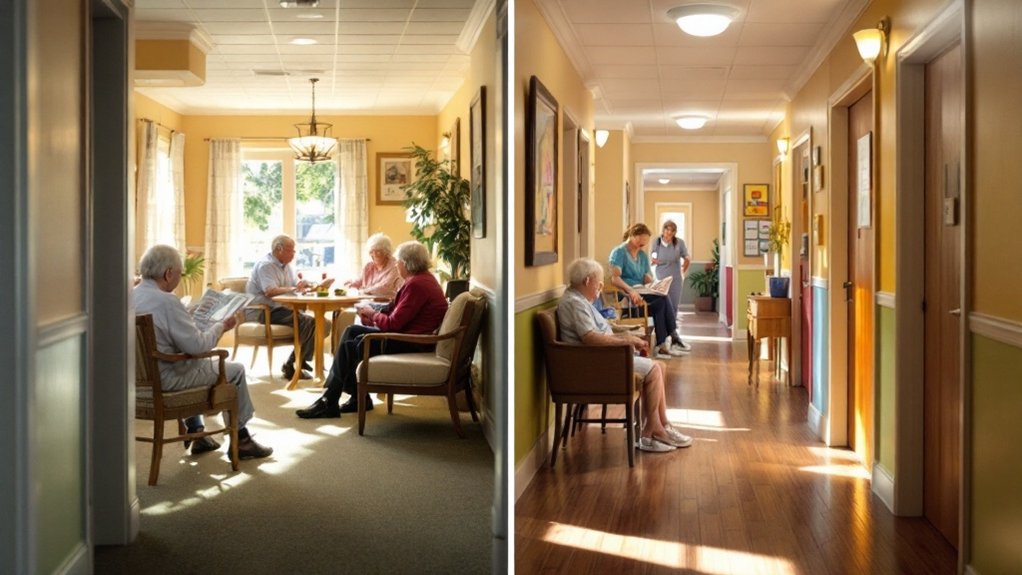Memory care facilities differ from assisted living through specialized cognitive support, enhanced security features, and higher staffing ratios that address the unique needs of residents with dementia. You'll find monthly costs averaging $6,160 for memory care versus $4,917 for assisted living, reflecting a 25% premium for dementia-specific services, secured environments, and specialized staff training. The distinction extends to programming, with memory care offering evidence-based cognitive therapies while assisted living focuses on general support – an essential factor in determining appropriate placement for your loved one's needs.

The critical decision between memory care and assisted living facilities represents a significant divergence in specialized care approaches, with memory care facilities commanding approximately 25% higher monthly costs while delivering targeted cognitive support through enhanced staff ratios and dementia-specific programming. The financial differential manifests in average monthly costs of $6,160 for memory care versus $4,917 for assisted living, reflecting the thorough nature of specialized dementia care services and heightened staffing requirements.
Memory care facilities distinguish themselves through sophisticated environmental design elements, incorporating secure entrances with door alarms, motion-sensor lighting, and remote monitoring systems that protect residents while promoting supervised independence. These purposeful design considerations extend to simplified layouts, enhanced wayfinding signage, and carefully selected color schemes that minimize cognitive confusion and support spatial orientation for residents with progressive memory disorders. Single-touch sinks and adaptive fixtures further accommodate the sensory changes experienced by memory care residents. Unlike traditional nursing homes, memory care facilities maintain structured daily routines that help reduce anxiety and confusion in residents with cognitive impairments. Families often find reassurance in these specialized environments, as they provide person-centered care tailored specifically to their loved ones' unique cognitive challenges.
The divergence in care approaches becomes particularly evident in staff training protocols and therapeutic programming. Memory care personnel receive extensive training in managing dementia-specific behaviors, including aggression and wandering tendencies, while maintaining lower staff-to-resident ratios for individualized attention. In contrast, assisted living staff focus on general support services without the specialized cognitive care training characteristic of memory care environments.
Your evaluation of these options should consider the targeted programming offered within each setting. Memory care facilities implement evidence-based cognitive stimulation activities and specialized therapies, including music therapy and behavior management programs, while assisted living communities emphasize broader social engagement and recreational activities. This programmatic distinction reflects the fundamental difference in resident populations, with memory care serving those requiring complex cognitive support and assisted living accommodating individuals maintaining relative independence despite requiring assistance with daily tasks.
The selection between these care models ultimately depends on the specific cognitive needs of the individual, with memory care offering thorough support for advanced dementia cases through specialized safety features, trained staff, and targeted programming, while assisted living provides a more independent environment with basic support services for those with minimal cognitive impairment.
Frequently Asked Questions
What Types of Memory Conditions Do Memory Care Facilities Typically Treat?
Memory care facilities primarily treat Alzheimer's disease and various forms of dementia, including vascular, Lewy body, and frontotemporal variants.
You'll find they're equipped to handle age-related cognitive decline, memory loss disorders, and certain neurological conditions affecting cognitive function.
The facilities specialize in managing progressive memory impairment through structured environments, with staff trained specifically in behavioral interventions and cognitive support techniques.
How Often Can Family Members Visit Residents in Memory Care Facilities?
You'll typically have daily access to visit your loved one in memory care facilities during standard hours (8:30 a.m. – 6:00 p.m.), though specific scheduling policies vary by facility.
Most institutions limit visits to two people simultaneously and require advance scheduling.
You'll need to undergo health screenings and follow PPE protocols, while designated caregivers often receive extended visitation privileges and may qualify for special accommodations during end-of-life situations.
Are Pets Allowed in Memory Care or Assisted Living Facilities?
Both memory care and assisted living facilities often allow pets, though policies vary considerably.
You'll find memory care facilities typically have stricter regulations due to safety concerns, with many offering robotic companion pets as alternatives.
Assisted living communities more commonly accept pets, requiring vaccination records and implementing size restrictions, while charging additional fees ranging from $200-500 initially plus monthly charges of $25-50 for pet maintenance.
What Happens if a Resident's Condition Deteriorates in Assisted Living?
If your loved one's condition deteriorates in assisted living, you'll need to evaluate care options, as the facility may not be equipped to handle increased medical needs.
You're likely to face three scenarios: transferring to a higher level of care facility, arranging additional external healthcare services, or shifting to memory care if cognitive decline is present.
Acute deterioration often results in hospital transfers due to assisted living's limited medical resources and staff-to-resident ratios.
How Are Staff Members Trained to Handle Dementia-Related Emergencies?
Staff members undergo intensive dementia-specific training that encompasses crisis intervention protocols, behavioral management techniques, and emergency response procedures.
You'll find they're required to complete 25-40 hours of specialized coursework covering aggression de-escalation, wandering prevention, and medical emergency protocols.
Their training emphasizes continuous monitoring through a high staff-to-resident ratio, typically 1:6 during day shifts, ensuring rapid response to cognitive decline episodes or safety incidents.









